
The Future
How is it that we will progress?
Sooner rather than later, either the United States, China, Russia or the European Union
(most likely some combination of the three), will take the first steps into space.

Eventually, we will put a moon base up and become a multi-planet species.
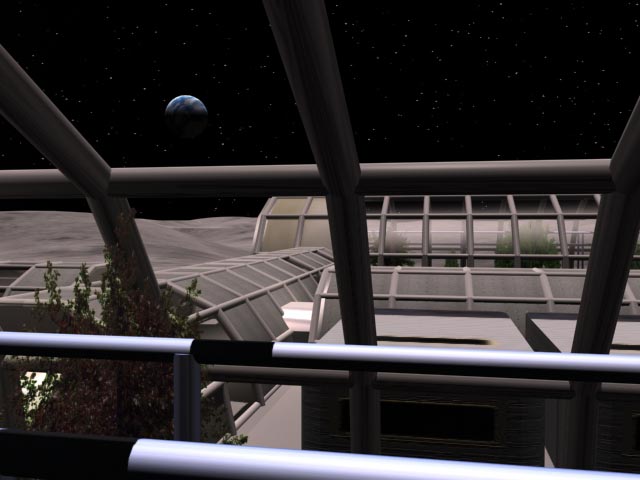
Our moon has no atmosphere, so the stars are out all the time. Earth appears about 4 times as large in the moon's sky as the moon does in the Earth's sky.
The astronauts on the moon in the late 1960's and and early 1970's could even see the continents on Earth!

After the moon base or moon colonization is Mars.
Our friendly red neighbor is ripe for being terraformed into an eventual Earth-like world.
With the moon we can only put bases there. With Mars in the longterm, we can create a new home.
In this view, we see Mars over the horizon of Phobos.
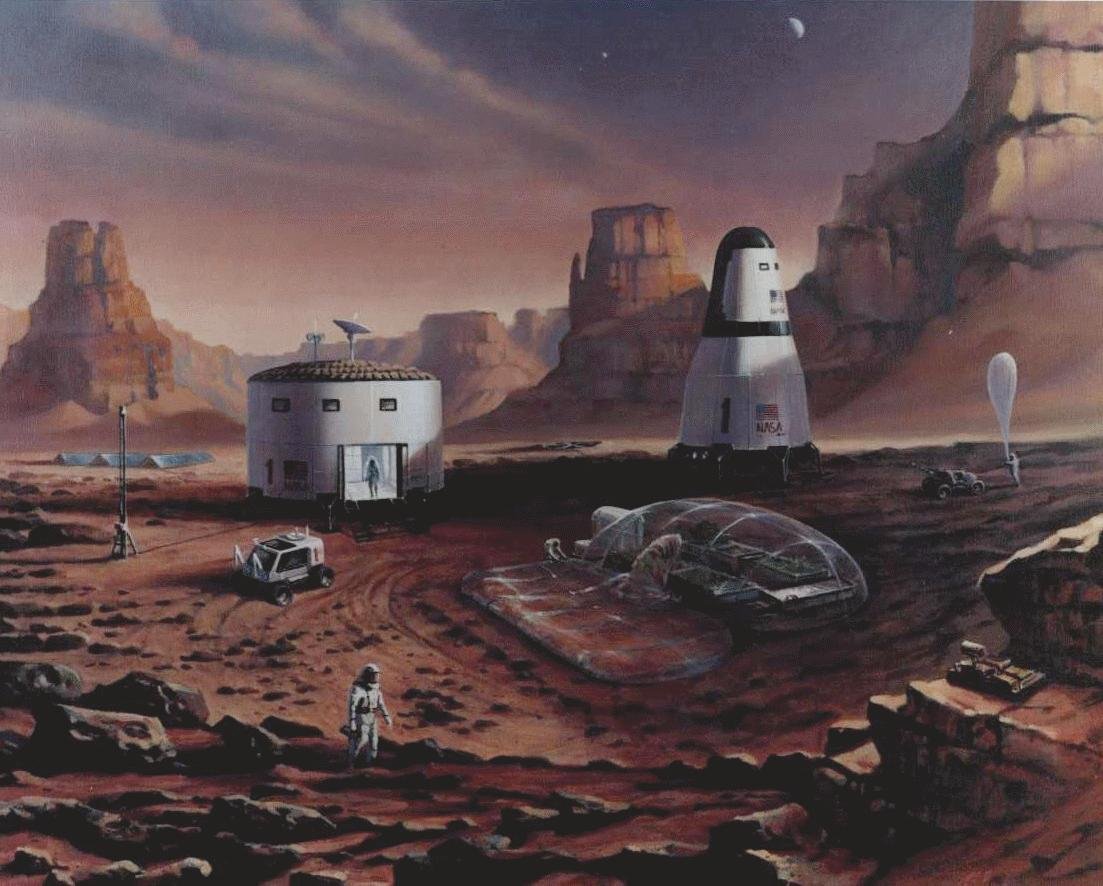
In the short run (decades), an early base like this one leading to more elaborate and planet-wide colonies will have to do.
But for the long run (centuries), terraforming Mars to be like the Earth, and human friendly, will be in the books.
Here we see the first astronauts beginning the first base.
...and onwards we fly to the 5th planet: The Jupiter System.
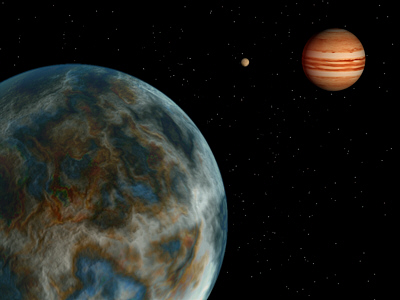
Down the road a bit, when we have firm settlement on Mars,
advanced bases on the Moon, space stations and a routine interplanetary shuttle
system between the three worlds, the Jupiter System, an entire Solar System
in minature, will beckon. Here we find four large moons and a small irregular one, among many tiny moonlets.
Three of the four large moons are waiting for bases, but the planet itself is not, being unsuitable for colonization.
Ganymede is shown here with Europa and Jupiter in the background.
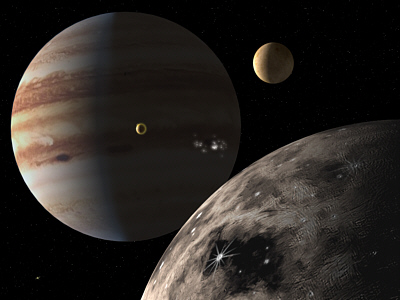
Not only Ganymede but Callisto will be waiting for us too. With Europa and Io in front of Jupiter, and one of the ever present
lightning storms on the dark side of the planet, a base here would certainly have a nice view.

Here on Ganymede is a good spot for a base, as is Callisto.
Using solar power in space as a free source of endless energy will certainly be the best method of generating power.
Already on Earth, we have conducted bio-sphere experiments successfully for indoor, hydroponic farming.
These lunar bases would operate on the same principles, writ large.
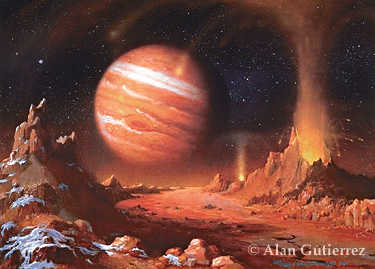
But unless you incline towards the occault, Io is not a nice place with a nice view! We won't be too interested in THIS moon of Jupiter,
with its volcanoes constantly sending molten lava up into space, only to fall back on the Moon. And on top of it all, Io is not a nice neighbor...
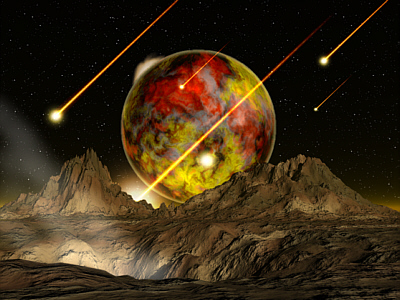
The small moon Amalthea (Jupiter's 5th largest) won't be any help to us either, because it is always being harassed
by Io's volcanic regurgitations, turning it redder all the time, and is also very close to the planet itself.

Yet the friendliest moon in the Jupiter system for long term development is Europa. Shown here with Io and the giant planet beyond, Europa is a candidate not only for a base, but for habitation. Its ocean is frozen on top right now, but with technology in the future, we may be able to harness the water and either create a waterworld of floating cities and such, (like Flostam Paradise in the movie 5th Element), or even engineer an atmosphere and create another kind of paradise.
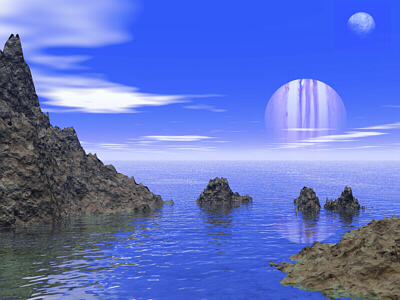
If we don't foolishly destroy ourselves now, it is hard to imagine how incredible the future can be. Its been 2000
years since Christ walked in Galilee, in a 1000 more, we could easily have Europa looking like this. Think about it.
Even so, a thousand years is a long time. In the meantime, our bases in the Jupiter System will be stepping stones for new ones in the Saturn System.
...and so, on we fly to the 6th planet: The Saturn System.
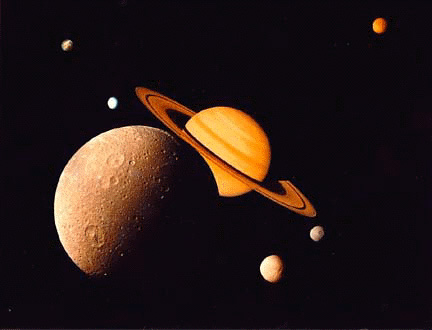
Here we find one large moon, four medium sized ones (Jupiter had none and our moon is large, so this is our first encounter with medium sized moons). We also find three smaller moons among many irregular moonlets.Saturn, like Jupiter, is not our interest for bases. There are a few moons however, that are.

Rhea (shown here with Tethys in the background), Iapetus and Dione are four medium size rock and ice moons that should be ok for bases,
but like Callisto and Ganymede at Jupiter, just ok. We won't be terraforming any of these kinds of moons (like our own)
anytime soon. Mars and Europa yes, these rock and ice moons no, only bases, which is good enough. Notice that Saturn
itself gives off as much light as the sun in this area of our Solar Neighborhood.

Here, Dione is shown with its interesting streaks left over from early ice volcanoes that are now quiet.
We are lucky to be alive at this time, when our Solar System is much, much quieter than it used to be!

A possible future method of making larger human colonies on these world is to literally re-create Earth there.
This is a solar powered colony on Dione.


Here we see the rock and ice environment of these four medium sized moons.
This is Iapetus looking at the planet's rings dead on, and we see Enceladus and also, near the rings, Mimas.

Mimas orbits very close to Saturn, but not among the rings. It is smaller and here we see the closest near miss to destruction anywhere,
the shot that almost shattered this lucky moon in the far distant past.

"And man shall have dominion over the Earth and the animals."
This is Enceladus, the brightest moon in the Solar System, with Iapetus in the way back and Saturn too.
The way to set up bases on these moons will be to prepare the ship that makes the trip out to double as the core of the future base when it lands.
Here we see such a ship arriving to start a new lunar base in the Saturn System, carrying humans out towards our destiny of solar dominion.

Orbiting the Lord of the Rings from a distance is the giant moon Titan, our primary interest at Saturn. Like Europa was at Jupiter. Titan is unique among moons in that it already has a substanial atmosphere, land and seas. It is our second largest moon and hold the best prospects for life outside of Earth, Europa and Mars. This is another place that can be more than just a base, it can be terraformed into an eventual human friendly world.

Already, Titan has excited interest among astronomers. In November 2004 this scene will really take place, as the Cassini
spacecraft from Earth enters orbit around Titan, sending down a probe to 'test the waters' for life and composition.
...and on we fly, to the 7th planet: the Uranus System...

The Uranus system is twice as far out from the sun as the Saturn system. But once we have gotten this far, our ships will certainly have the capability for very fast travel. It took Voyager 3 years to get to Saturn. By the time we colonize the Moon, Mars, the Jupiter and the Saturn Systems, the Uranus System will definitely be "nearer" than it is today. What will we find there? First of all, the planet itself is weird: Uranus is tilted on its side and the moons orbit 'north and south' instead of 'east and west.' It has a thin set of rings and four medium size rock and ice moons (like Saturn's four medium rock moons, and Jupiter's two) to give us a nice hard place to land. Here in this view is Oberon, with Miranda above it and Titania to the right, which is really 'south.'

The four moons are Titania, Oberon, Umbriel and Ariel. Two of them, Oberon and Umbriel reflect very little light and have dark surfaces,
as we can see by this view of Umbriel. Ariel (upper left) and Titania are lighter. All four have about the same value as future outposts.

Just like before, new explorers and voyagers will build bases among the moons of Uranus. Here we see two pioneering ships arriving in the Uranus System passing not one of the four medium sized moons that is their destination, but one of the smaller moonlets, only miles across, that make up the majority of the natural satellites around Jupiter, Saturn, Uranus and Neptune.

In this view we see Titania, the largest moon in the Uranus System, with an edge on view of the pretty planet and its sister moons,
Ariel, Umbriel in the middle and Oberon below that.

Here we see a base on the darker colored moon Oberon (or possibly Umbriel, they both look pretty much alike!)

What will humanity be like in the future? Will they scoff at us today like we scoff at Medieval people? Or will they remember the truth of how they got to be a spacefaring civilization? It may be fitting to, once we are out here, remember our human past. We may not get to Uranus for the next 200 years but imagine, will some united human government pay their respects to the first nation in space (Russia- Sputnik 1957) by building a base that is more than just utilitarian? I think we can all hope that we will one day be vindicated as the greater angels of our nature prevail against fear and inability.
...and onwards we fly, to the 8th planet: the Neptune System

And onwards we fly.
The 8th planet is Neptune. Doubly as far as Uranus, but about the same color and composition. It took Voyager 12 years to get to Neptune from Earth (1977-1989). But what surprises Neptune has for us. On approach we find a very far satellite called Nereid in its erratic orbit far from the planet. Nereid is not a good candidate for a base because it is irregular and small. In fact, Neptune does not have any moons that are suitable for human bases except one:

Triton. Triton is the size of Pluto and probably knew Pluto once, because either Pluto is a run away moon of Neptune that broke free from its gravity or Triton had been a planet like Pluto but got caught in Neptune's gravity and became a moon instead. Triton has ice guysers and is especially cold because it is so white in color and reflects all the light back into space. It is a very bright moon for being this far out-- and is the best place in the Neptune System (really the only place) for a moon base. What is Triton like on the surface?
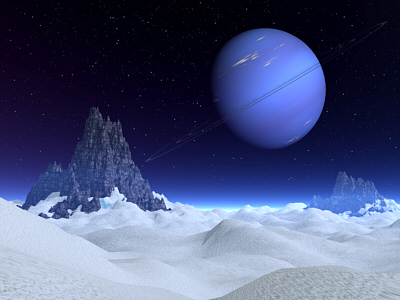
Rock and super cold ice. The beautiful planet gives a blue radiance to its large moon's landscape. Our base here will need a good heater.

Triton has many terrains (remember it is the size of a small planet), and here we see one of the amazing ice volcanoes firing out matter into a plume that falls back to the surface. These plumes of ice amazed scientists on Earth when Voyager discovered them in 1989.

Triton's orbit takes it closer and further from Neptune depending, and it also orbits in reverse of all the other moons in the Solar System since it didn't originate from Neptune naturally, but was caught by the planet's gravity from deep space. Here, people have built a base underground.
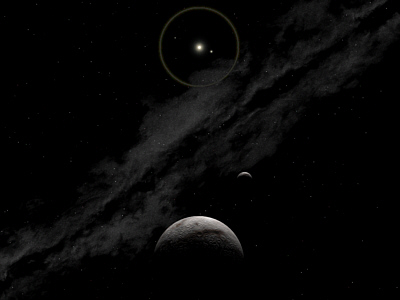
Human Beings are in for a long run in colonizing the Solar Neighborhood, but even that has an end point. Our star system is finite. Here at the end of our Grand Tour, we find the 9th planet, Pluto. All alone with its moon, orbiting the Sun once every 248 years. Pluto and Charon are just fine for a base, they do not (so far as we know) have any geological problems or anything, they are just very remote. Here we see the sun as just a bright star in the sky. The other bright object is mighty Jupiter, outshining even Neptune with its sheer size.

At the end of the road are these two sentinals, Pluto's thin atmosphere crystalizing as ice and falling to the surface during the long winter, and Charon, quite large in the sky, making its doleful rounds. Since both are rotating at the same speed, Charon would always be right where it is now, only the background of deep space would change, and the light from the sun. If you wanted to see a different view of Charon from Pluto, you would have to move yourself.
Well, there it is. When all is said and done, we see now that there is a LOT of potential for us in the coming millenium.
To be a person that encourages us in this direction for our grandchildren, join the Planetary Society.
Back to Hudson Back to New Port Richey